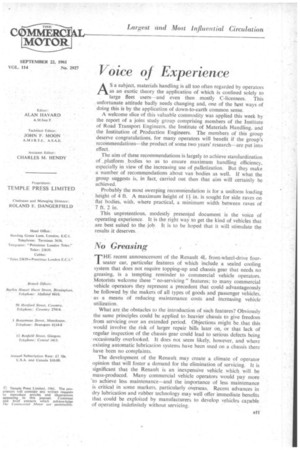Voice of Experience
Page 45

If you've noticed an error in this article please click here to report it so we can fix it.
AS a subject, materials handling is all too often regarded by operators as an exotic theory the application of which is confined solely to large fleet users—and even then mostly C-licensees. This unfortunate attitude badly needs changing and, one of the best ways of doing this is by the application of down-to-earth common sense.
A welcome slice of this valuable commodity was applied this week by the report of a joint study group comprising members of the Institute of Road Transport Engineers, the Institute of Materials Handling, and the Institution of Production Engineers. The members of this group deserve congratulations, for many operators will benefit if the group's recommendations—the product of some two years' research—are put into effect.
The aim of these recommendations is largely to achieve standardization of _platform bodies so as to ensure maximum handling efficiency, especially in view of the increasing use of palletization. But they make a number of recommendations about van bodies as well. If what the group suggests is, in fact, carried out then that aim will certainly be achieved.
Probably the most sweeping recommendation is for a uniform loading height of 4 ft. A maximum height of li in. is sought for side raves on flat bodies, with, where practical, a minimum width between raves of 7 ft. 2 in.
This unpretentious, modestly presented document is the voice of operating experience. It is the right way to get the kind of vehicles that are best suited to the job. It is to be hoped that it will stimulate the results it deserves.
No Greasing
THE recent announcement of the Renault 4L front-wheel-drive fourseater car, particular features of which include a sealed cooling system that does not require topping-up and chassis gear that needs no greasing, is a tempting reminder to commercial vehicle operators. Motorists welcome these " no-servicing " features; to many commercial vehicle operators they represent a precedent that could advantageously be followed by the makers of all types of goods and passenger vehicles. as a means of reducing maintenance costs and increasing vehicle utilization.
What are the obstacles to the introduction of such features? Obviously the same principles could be applied to heavier chassis to give freedom from servicing over an extended period. Objections might be.that this would involve the risk of larger repair bills later on, or that lack of regular inspection of the chassis gear could lead to serious defects being occasionally overlooked. It does not seem likely, however, and where • existing automatic lubrication systems have been used on a chassis there have been no complaints.
The development of the Renault may create a climate of operator opinion that will foster a demand for the elimination of servicing. It is significant that the Renault is an inexpensive vehicle which will be mass-produced. Many commercial vehicle operators would pay more *to achieve less maintenance—and the importance of less maintenance is critical in some markets, particularly overseas. Recent advances in dry lubrication and rubber technology may well offer immediate benefits that could be exploited by manufacturers to develop vehicles capable of operating indefinitely without servicing.




































































































































